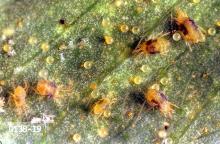Includes
Pacific spider mite (Tetranychus pacificus)
Strawberry spider mite (Tetranychus turkestani)
Twospotted spider mite (Tetranychus urticae)
Pest description, crop damage and life history
See:
Common Pests of Vegetable Crops
Pest monitoring There is no precise survey technique for evaluating spider mite infestations. Infestations usually begin on the lower portions of the plants and move upward as mite numbers increase. Evaluating spider mite infestations is most efficient if randomly selected, older, lower leaves are picked and inspected for stippling on the upper surface and webbing, mites, and feeding scars on the lower surface. Areas in the field where dust accumulates, or weedy areas are good places to scout for spider mites.
Management-biological control
Spider mite populations may be held at very low levels by a number of insect and mite predators, particularly early in the year. Thrips are effective early season predators, feeding primarily on spider mite eggs.
Commercial releases of predatory mites are used to control spider mites in greenhouses. In Florida and California, predatory mites are used to control spider mites in strawberries. Spider mites provide an important food source for predators such as minute pirate and bigeyed bugs.
Management-cultural control
Spider mite problems can be reduced by keeping fields and field margins clean of weed hosts. Spider mite populations may increase more rapidly in areas where dust deposits are heavy. Reducing dust may reduce the spider mite problem. Spider mites are usually less severe in sprinkler-irrigated fields than in drip or furrow-irrigated fields. Excessive nitrogen fertilization also may contribute to population buildup. Minimizing early year insecticide applications of broad spectrum insecticides, which reduce populations of beneficial insects, will reduce spider mite outbreaks.
Management-chemical control: HOME USE
- azadirachtin (neem oil)-Some formulations are OMRI-listed for organic use.
- horticultural oil-Some formulations are OMRI-listed for organic use.
- insecticidal soap-Apply control measures when mites first appear, and repeat application as necessary. Good coverage, especially on undersides of leaves, is essential. Some formulations are OMRI-listed for organic use.
- plant essential oils (clove, garlic, rosemary etc.)-Some formulations are OMRI-listed for organic use.
- sulfur-Some formulations are OMRI-listed for organic use.
Management-chemical control: COMMERCIAL USE
- abamectin (Agri-Mek SC) 1.75 to 3.5 fl oz/A. PHI 7 days. REI 12 hrs. Do not exceed 10.25 fl oz/A per season. To avoid illegal residues, mix with a surfactant as recommended by the label. Washington only.
- hexythiozox (Onager Optek) 10-24 fl oz/A, PHI 14 days. REI 12 hrs. Do not apply more than one application per season. Do not harvest or graze bean vines for hay or forage.
- insecticidal soap (M-Pede) at 1 to 2% (see label for gal/A). Potassium salts of fatty acids. PHI 0 days.
- naled (Dibrom 8) at 0.94 lb ai/A. PHI 1 day. REI 48 hr. Do not apply within 25 ft of an aquatic habitat, 150 ft if applied by air.
- phorate (Thimet20-G)-Do not exceed 1.5 lb ai/A. PHI 60 days. REI 48 hr, or 72 hr if annual rainfall is less than 25 inches. Use at planting only. Do not graze or feed to livestock. Toxic to fish and wildlife.
- sulfur at 2.25 to 6.75 lb ai/A. REI 24 hr. PHI: consult processor.




